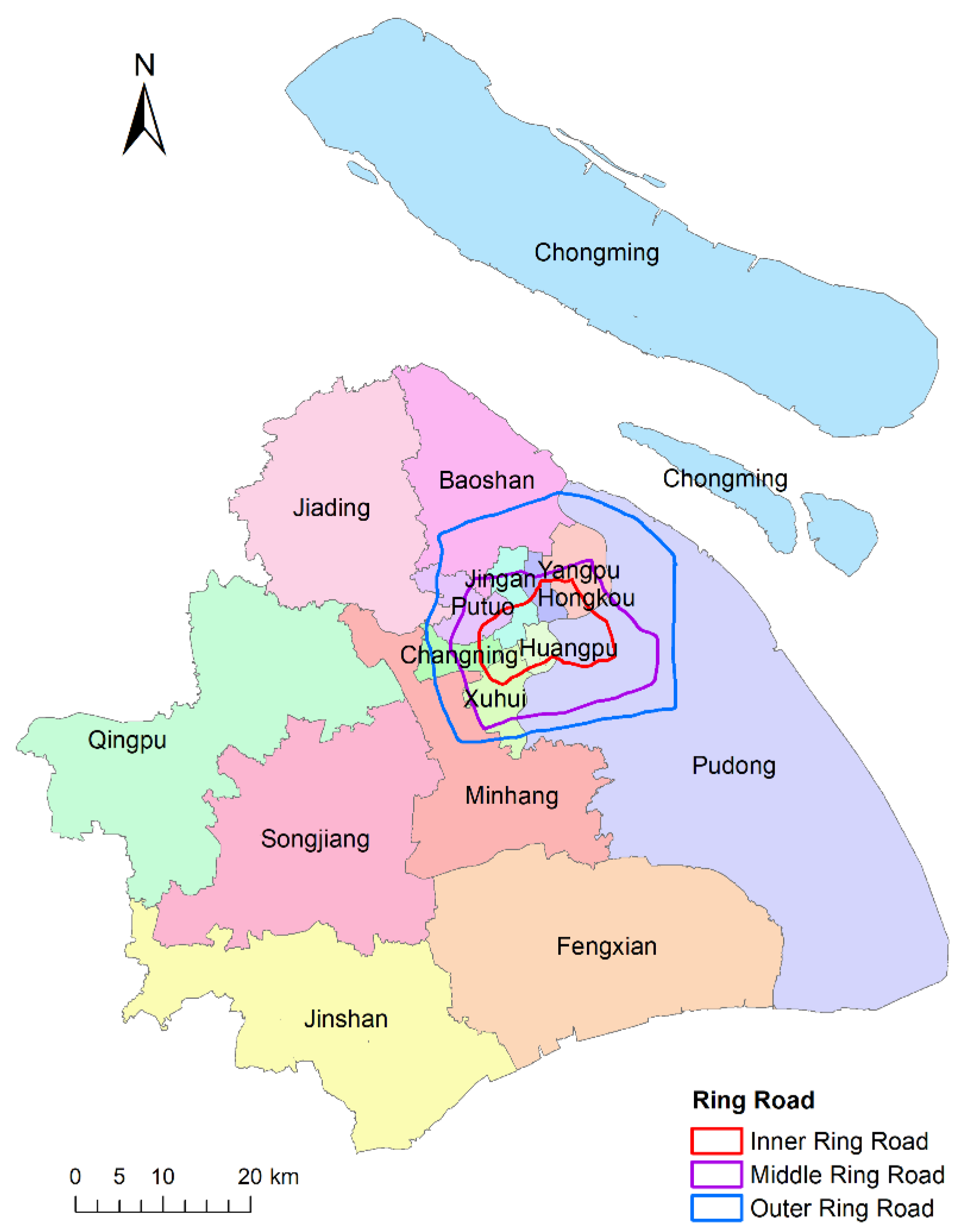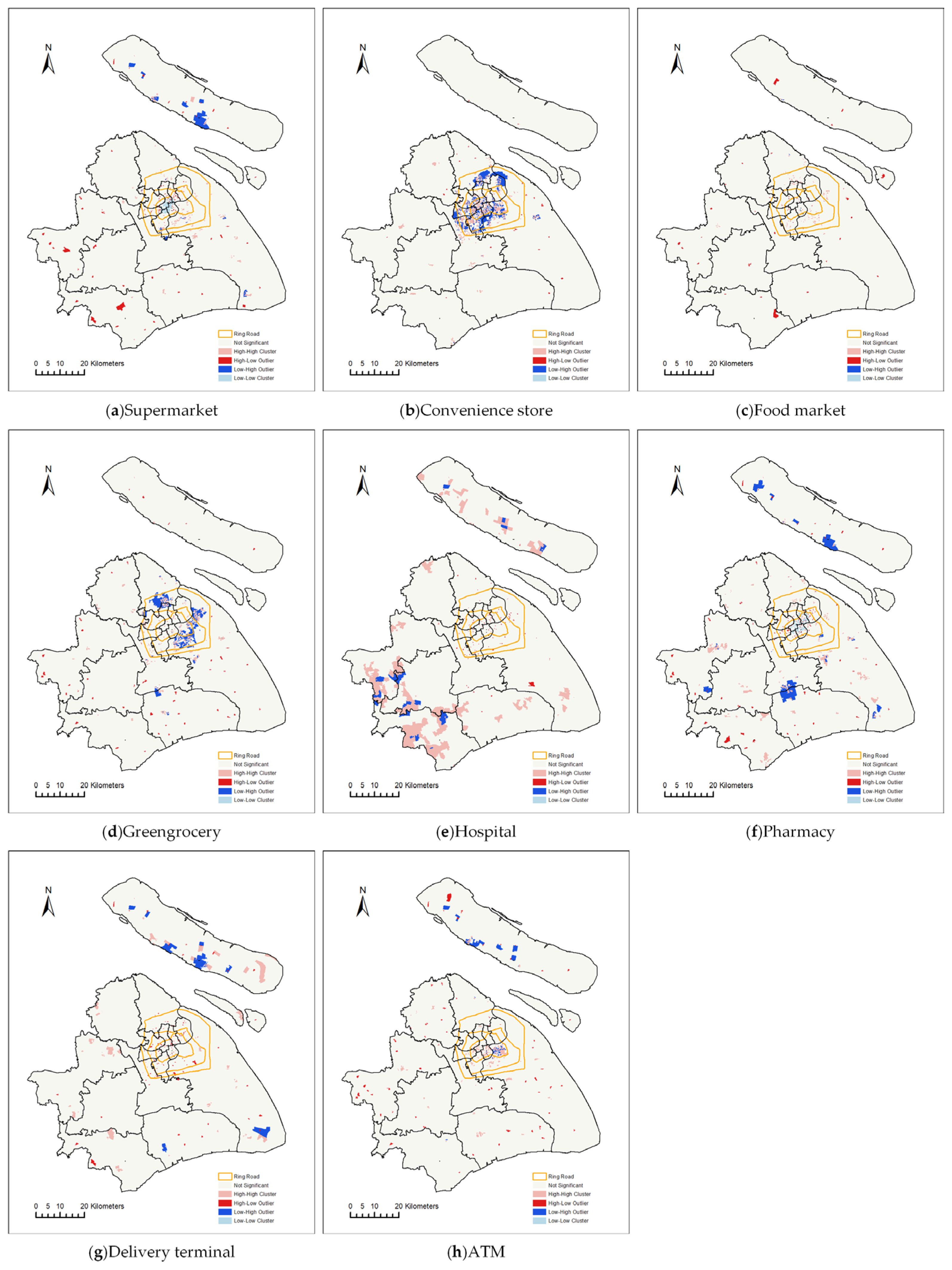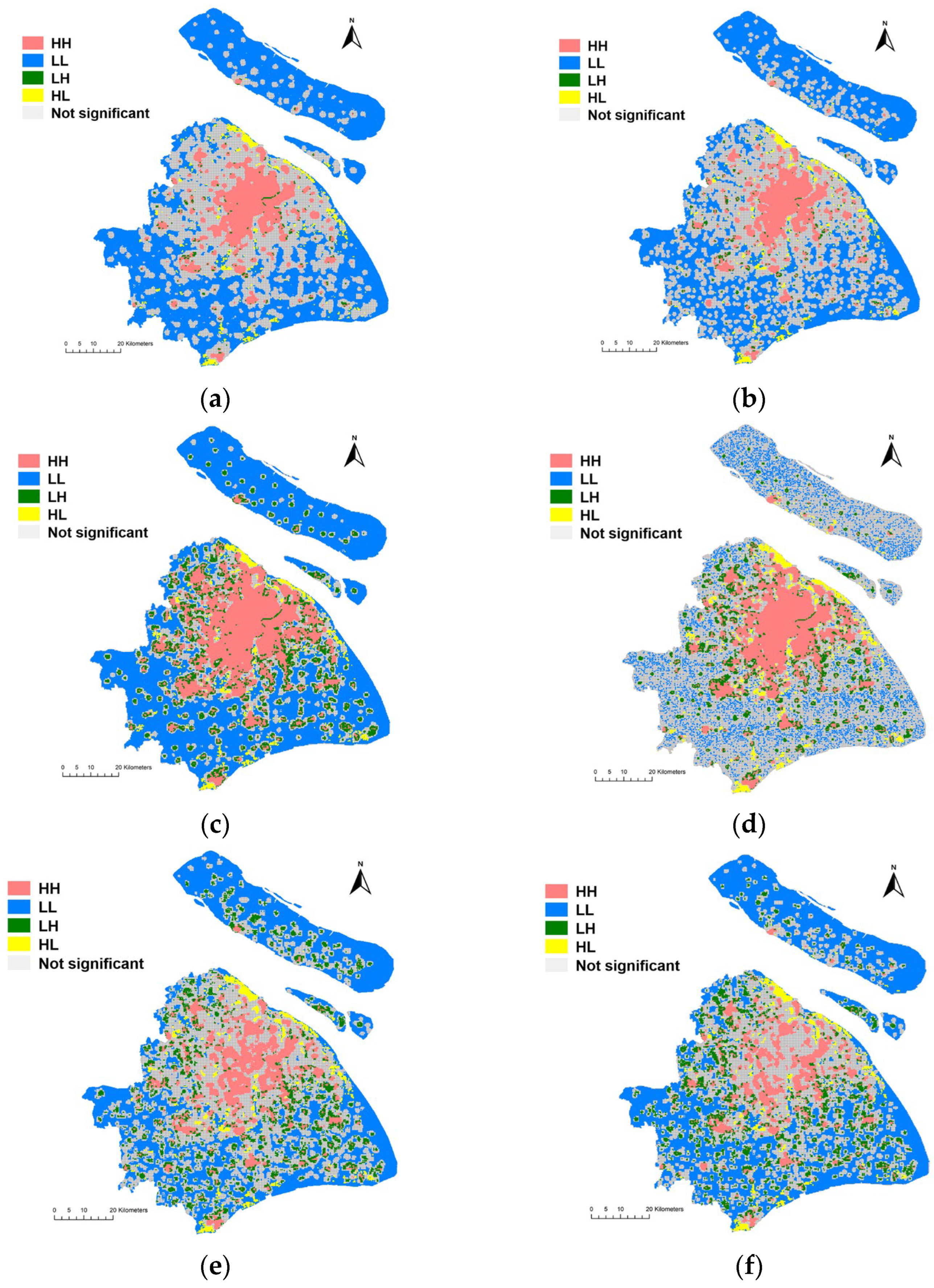Community Resilience in Accessing Essential Service Facilities Considering Equity and Aging Demand: A Case of Shanghai, China
Abstract
:1. Introduction
1.1. Background
1.2. Community Resilience
1.3. Equity
1.4. Research Aim
- (1)
- Residents should be able to reach essential services within walking distance. During the lockdown period, people have to stay at home and many public transport services are decreased, so essential service facilities should be accessible within walking range.
- (2)
- The types of essential service facilities should be complete. The specific needs of the elderly in the community should be considered, especially in areas with high residential density for the elderly.
- (3)
- Regardless of the high or low population density of the community, the quantity of essential service facilities per capita should be balanced as much as possible. Areas with a large number of essential service facilities may also be densely populated. Due to capacity limitations in public places during lockdown, the per capita quantity of facilities needs to be balanced.
2. Materials and Methods
2.1. Study Area
2.2. Data
2.3. Methodological Framework
- Measuring the spatial distribution of eight types of essential service facilities.
- (1)
- Measuring the spatial distribution of points through the Nearest Neighbor Index (space-based).
- (2)
- Spatial cluster and spatial outlier analysis of per capita quantity of essential service facilities in community units (population-based).
- Establishing three indexes to analyze the ability of the elderly and the general population to access essential service facilities.
- Measuring the equity between the elderly and the general population in these three indexes through the Lorenz curve and the Gini coefficient.
- Exploring spatial correlations between population density and three indexes using the Bivariate Local Indicators of Spatial Association measure.
- Discussing implications for policy makers to improve community resilience and address inequities.
2.4. Spatial Distribution Characteristics of 8 Types of Facilities
2.4.1. The Nearest Neighbor Index
2.4.2. Local Indicators of Spatial Association
- Hot Spots: Locations with high values and similar neighbors (High–High clusters);
- Cold Spots: Locations with low values and similar neighbors (Low–Low clusters);
- Spatial Outliers: Locations with high values but with low-value neighbors (High–Low outliers) and locations with low values but with high values of neighbors (Low–High outliers).
2.5. Measurement of Community Resilience in Accessing Essential Service Facilities through Three Indexes
2.5.1. The Walking Range Area for the Elderly and the General Population
2.5.2. Demand Accessibility Index
2.5.3. Diversity Index
2.5.4. Per Capita Quantity Index
2.5.5. Min–Max Normalization of the Data
2.6. Equity Assessment
2.7. Bivariate LISA
3. Results
3.1. Spatial Distribution Patterns of Eight Essential Service Facilities
3.1.1. The Nearest Neighbor Index of the Eight Essential Service Facilities
3.1.2. The Cluster and Outlier Analysis of Eight Essential Service Facilities
3.2. Community Resilience in Accessing Essential Service Facilities
3.2.1. Demand Accessibility Index
3.2.2. Diversity Index
3.2.3. Per Capita Quantity Index
3.3. Spatial Equity of Essential Service Facilities
3.4. Spatial Correlations between Population Density and Three Indexes
4. Discussion
5. Conclusions
Author Contributions
Funding
Data Availability Statement
Acknowledgments
Conflicts of Interest
References
- Abdullah, M.; Dias, C.; Muley, D.; Shahin, M. Exploring the impacts of COVID-19 on travel behavior and mode preferences. Transp. Res. Interdiscip. Perspect. 2020, 8, 100255. [Google Scholar]
- Kabiraj, A.; Pal, D.; Bhattacherjee, P.; Chatterjee, K.; Majumdar, R.; Ganguly, D. How successful is a lockdown during a pandemic? In Proceedings of the 2020 IEEE 17th India Council International conference (INDICON), New Delhi, India, 10–13 December 2020; pp. 1–6. [Google Scholar]
- Elcheroth, G.; Drury, J. Collective resilience in times of crisis: Lessons from the literature for socially effective responses to the pandemic. Br. J. Soc. Psychol. 2020, 59, 703–713. [Google Scholar]
- Yip, W.; Ge, L.; Ho, A.H.Y.; Heng, B.H.; Tan, W.S. Building community resilience beyond COVID-19: The Singapore way. Lancet Reg. Health–West. Pac. 2021, 7, 100091. [Google Scholar]
- Fransen, J.; Peralta, D.O.; Vanelli, F.; Edelenbos, J.; Olvera, B.C. The emergence of urban community resilience initiatives during the COVID-19 pandemic: An international exploratory study. Eur. J. Dev. Res. 2022, 34, 432–454. [Google Scholar]
- Bento, F.; Couto, K.C. A behavioral perspective on community resilience during the COVID-19 pandemic: The case of Paraisópolis in São Paulo, Brazil. Sustainability 2021, 13, 1447. [Google Scholar]
- Mitchell, D.; Barth, B.; Ho, S.; Sait, M.S.; McEvoy, D. The benefits of fit-for-purpose land administration for urban community resilience in a time of climate change and COVID-19 pandemic. Land 2021, 10, 563. [Google Scholar]
- Zhang, J.; Wang, T. Urban resilience under the COVID-19 pandemic: A quantitative assessment framework based on system dynamics. Cities 2023, 136, 104265. [Google Scholar]
- Suleimany, M.; Mokhtarzadeh, S.; Sharifi, A. Community resilience to pandemics: An assessment framework developed based on the review of COVID-19 literature. Int. J. Disaster Risk Reduct. 2022, 80, 103248. [Google Scholar]
- Keenan, J.M. COVID, resilience, and the built environment. Environ. Syst. Decis. 2020, 40, 216–221. [Google Scholar]
- United Nations Human Settlements Programme. Cities and Pandemics: Towards a More Just, Green and Healthy Future; United Nations Human Settlements Programme (UN-Habitat): Nairobi, Kenya, 2021. [Google Scholar]
- Bruneau, M.; Chang, S.E.; Eguchi, R.T.; Lee, G.C.; O’Rourke, T.D.; Reinhorn, A.M.; Shinozuka, M.; Tierney, K.; Wallace, W.A.; Von Winterfeldt, D. A framework to quantitatively assess and enhance the seismic resilience of communities. Earthq. Spectra 2003, 19, 733–752. [Google Scholar]
- Barker, K.; Ramirez-Marquez, J.E.; Rocco, C.M. Resilience-based network component importance measures. Reliab. Eng. Syst. Saf. 2013, 117, 89–97. [Google Scholar]
- Chang, S.E.; Brown, C.; Handmer, J.; Helgeson, J.; Kajitani, Y.; Keating, A.; Noy, I.; Watson, M.; Derakhshan, S.; Kim, J. Business recovery from disasters: Lessons from natural hazards and the COVID-19 pandemic. Int. J. Disaster Risk Reduct. 2022, 80, 103191. [Google Scholar]
- Contreras, D.; Blaschke, T.; Hodgson, M.E. Lack of spatial resilience in a recovery process: Case L’Aquila, Italy. Technol. Forecast. Soc. Chang. 2017, 121, 76–88. [Google Scholar]
- Dempsey, N.; Bramley, G.; Power, S.; Brown, C. The social dimension of sustainable development: Defining urban social sustainability. Sustain. Dev. 2011, 19, 289–300. [Google Scholar]
- Talen, E. Neighborhoods as service providers: A methodology for evaluating pedestrian access. Environ. Plan. B Plan. Des. 2003, 30, 181–200. [Google Scholar]
- Valinejad, J.; Guo, Z.; Cho, J.-H.; Chen, R. Measuring community resilience during the COVID-19 based on community wellbeing and resource distribution. J. Soc. Comput. 2022, 3, 322–344. [Google Scholar]
- Snuggs, S.; McGregor, S. Food & meal decision making in lockdown: How and who has COVID-19 affected? Food Qual. Prefer. 2021, 89, 104145. [Google Scholar]
- Gómez-Escoda, E.; Crosas, C. Anatomy of the Critical Urban Mixedness: The Barcelona Eixample Grid during the Lockdown 2020. In Proceedings of the XXVIII International Seminar on Urban Form ISUF2021: Urban form and The Sustainable and Prosperous Cities, Glasgow, Scotland, 29 June–3 July 2021; pp. 768–775. [Google Scholar] [CrossRef]
- Chatterjee, K.; Shankar, S.; Chatterjee, K.; Yadav, A.K. Coronavirus disease 2019 in India: Post-lockdown scenarios and provisioning for health care. Med. J. Armed Forces India 2020, 76, 387–394. [Google Scholar]
- Foli, R.K.; Ohemeng, F.L. “Provide our basic needs or we go out”: The COVID-19 pandemic lockdown, inequality, and social policy in Ghana. Policy Soc. 2022, 41, 217–230. [Google Scholar]
- Figliozzi, M.; Unnikrishnan, A. Home-deliveries before-during COVID-19 lockdown: Accessibility, environmental justice, equity, and policy implications. Transp. Res. Part D Transp. Environ. 2021, 93, 102760. [Google Scholar]
- Giebel, C.; Ivan, B.; Burger, P.; Ddumba, I. Impact of COVID-19 public health restrictions on older people in Uganda:“hunger is really one of those problems brought by this COVID”. Int. Psychogeriatr. 2022, 34, 805–812. [Google Scholar]
- Song, Z. The geography of online shopping in China and its key drivers. Environ. Plan. B Urban Anal. City Sci. 2022, 49, 259–274. [Google Scholar]
- Biggs, C.; Chande, A.; Matthews, E.; Mercier, P.; Wang, A.; Zou, L. What China Reveals about the Future of Shopping. Available online: https://www.bcg.com/publications/2017/retail-globalization-china-reveals-future-shopping (accessed on 4 May 2017).
- Béné, C.; Bakker, D.; Chavarro, M.J.; Even, B.; Melo, J.; Sonneveld, A. Global assessment of the impacts of COVID-19 on food security. Glob. Food Secur. 2021, 31, 100575. [Google Scholar]
- Laborde, D.; Martin, W.; Swinnen, J.; Vos, R. COVID-19 risks to global food security. Science 2020, 369, 500–502. [Google Scholar]
- Ellison, B.; McFadden, B.; Rickard, B.J.; Wilson, N.L. Examining food purchase behavior and food values during the COVID-19 pandemic. Appl. Econ. Perspect. Policy 2021, 43, 58–72. [Google Scholar]
- Rejeb, A.; Rejeb, K.; Appolloni, A.; Iranmanesh, M.; Treiblmaier, H.; Jagtap, S. Exploring food supply chain trends in the COVID-19 era: A bibliometric review. Sustainability 2022, 14, 12437. [Google Scholar]
- Pereira, R.H.; Braga, C.K.V.; Servo, L.M.; Serra, B.; Amaral, P.; Gouveia, N.; Paez, A. Geographic access to COVID-19 healthcare in Brazil using a balanced float catchment area approach. Soc. Sci. Med. 2021, 273, 113773. [Google Scholar]
- Xu, W.; Xiang, L.; Proverbs, D.; Xiong, S. The influence of COVID-19 on community disaster resilience. Int. J. Environ. Res. Public Health 2021, 18, 88. [Google Scholar]
- De La Fuente, A.; Jacoby, H.G.; Lawin, K.G. Impact of the West African Ebola epidemic on agricultural production and rural welfare: Evidence from Liberia. J. Afr. Econ. 2020, 29, 454–474. [Google Scholar]
- Sasson, I. Age and COVID-19 mortality. Demogr. Res. 2021, 44, 379–396. [Google Scholar]
- Lak, A.; Asl, S.S.; Maher, A. Resilient urban form to pandemics: Lessons from COVID-19. Med. J. Islam. Repub. Iran 2020, 34, 71. [Google Scholar]
- Mueller, A.L.; McNamara, M.S.; Sinclair, D.A. Why does COVID-19 disproportionately affect older people? Aging 2020, 12, 9959. [Google Scholar]
- Bureau, S.M.S. The Seventh National Population Census of the People’s Republic of China. Available online: https://tjj.sh.gov.cn/zdlyxxgk/20210701/64f46d9879094179993177a94dfc0f2f.html (accessed on 18 May 2021).
- Times, G. Aging of Beijing, Shanghai Populations More Serious Than National Average. Available online: https://www.globaltimes.cn/page/202105/1223930.shtml (accessed on 19 May 2021).
- Molarius, A.; Janson, S. Self-rated health, chronic diseases, and symptoms among middle-aged and elderly men and women. J. Clin. Epidemiol. 2002, 55, 364–370. [Google Scholar]
- Pickering, G.; Brunet, F.; Roussel, M.; Pastor, J. Evaluation of the offer of physical activity for the elderly in a region of France. Arch. Gerontol. Geriatr. 2001, 33, 1–6. [Google Scholar]
- Clark, P.J.; Evans, F.C. Distance to nearest neighbor as a measure of spatial relationships in populations. Ecology 1954, 35, 445–453. [Google Scholar]
- Thompson, H. Distribution of distance to nth neighbour in a population of randomly distributed individuals. Ecology 1956, 37, 391–394. [Google Scholar]
- Wong, W.; Lee, J. Statistical Analysis of Geographic Information with ArcView GIS and ArcGIS; Wiley: Hoboken, NJ, USA, 2005. [Google Scholar]
- Sajjad, M.; Chan, J.C.; Kanwal, S. Integrating spatial statistics tools for coastal risk management: A case-study of typhoon risk in mainland China. Ocean. Coast. Manag. 2020, 184, 105018. [Google Scholar]
- Anselin, L. Local indicators of spatial association—LISA. Geogr. Anal. 1995, 27, 93–115. [Google Scholar]
- Getis, A.; Ord, J.K. The analysis of spatial association by use of distance statistics. Geogr. Anal. 1992, 24, 189–206. [Google Scholar]
- Penchansky, R.; Thomas, J.W. The concept of access: Definition and relationship to consumer satisfaction. Med. Care 1981, 19, 127–140. [Google Scholar]
- Guzman, L.A.; Arellana, J.; Oviedo, D.; Aristizábal, C.A.M. COVID-19, activity and mobility patterns in Bogotá. Are we ready for a ‘15-minute city’? Travel Behav. Soc. 2021, 24, 245–256. [Google Scholar]
- Bohannon, R.W. Comfortable and maximum walking speed of adults aged 20–79 years: Reference values and determinants. Age Ageing 1997, 26, 15–19. [Google Scholar]
- Duim, E.; Lebrão, M.L.; Antunes, J.L.F. Walking speed of older people and pedestrian crossing time. J. Transp. Health 2017, 5, 70–76. [Google Scholar]
- Hansson, L.; Holmberg, U.; Post, A. Reorganising grocery shopping practices–the case of elderly consumers. Int. Rev. Retail. Distrib. Consum. Res. 2022, 32, 351–369. [Google Scholar]
- Shen, H.; Namdarpour, F.; Lin, J. Investigation of online grocery shopping and delivery preference before, during, and after COVID-19. Transp. Res. Interdiscip. Perspect. 2022, 14, 100580. [Google Scholar]
- Kongkaew, M.; Thipjumnong, A. New Normal Payment Method among Elderly in COVID-19 Pandemic. Asia Soc. Issues 2023, 16, e257473. [Google Scholar]
- Wang, X.; Jiang, L. Research on Online Shopping Demand of Chinese Elderly under the Background of Aging. Int. J. Educ. Humanit. 2021, 1, 16–20. [Google Scholar]
- Chen, D.; Wang, C.; Liu, Y. How household food shopping behaviors changed during COVID-19 lockdown period: Evidence from Beijing, China. J. Retail. Consum. Serv. 2023, 75, 103513. [Google Scholar]
- WHO. Health at a Glance: Asia/Pacific 2020 Measuring Progress towards Universal Health Coverage: Measuring Progress towards Universal Health Coverage; OECD Publishing: Paris, France, 2020. [Google Scholar]
- Huang, Y.; Wang, X.; Wang, X. Mobile payment in China: Practice and its effects. Asian Econ. Pap. 2020, 19, 1–18. [Google Scholar]
- Jiao, R. Is There a Barrier between Seniors and Smartphone Use in The Internet Age? A Study of Digital Disconnection among Older Adults. In SHS Web of Conferences; EDP Sciences: Les Ulis, France, 2023. [Google Scholar]
- Weng, M.; Ding, N.; Li, J.; Jin, X.; Xiao, H.; He, Z.; Su, S. The 15-minute walkable neighborhoods: Measurement, social inequalities and implications for building healthy communities in urban China. J. Transp. Health 2019, 13, 259–273. [Google Scholar]
- Lian, J.-W.; Yen, D.C. Online shopping drivers and barriers for older adults: Age and gender differences. Comput. Hum. Behav. 2014, 37, 133–143. [Google Scholar]
- Jacobs, J. The Death and Life of Great American Cities; Vintage: New York, NY, USA, 2016. [Google Scholar]
- Christian, H.E.; Bull, F.C.; Middleton, N.J.; Knuiman, M.W.; Divitini, M.L.; Hooper, P.; Amarasinghe, A.; Giles-Corti, B. How important is the land use mix measure in understanding walking behaviour? Results from the RESIDE study. Int. J. Behav. Nutr. Phys. Act. 2011, 8, 55. [Google Scholar]
- Lorenz, M.O. Methods of measuring the concentration of wealth. Publ. Am. Stat. Assoc. 1905, 9, 209–219. [Google Scholar]
- Delbosc, A.; Currie, G. Using Lorenz curves to assess public transport equity. J. Transp. Geogr. 2011, 19, 1252–1259. [Google Scholar]
- Rezaei, S.; Nouri, B. Evaluation of inequalities in the distribution of health resources by Gini coefficient and Lorenz curve: A case study in Kurdistan province from 2006 to 2013. Sci. J. Kurd. Univ. Med. Sci. 2015, 20, Pe1–Pe11. [Google Scholar]
- Melkamu, M.; Bannor, R.K. Estimation of agricultural resource inequality in India using Lorenz curve and Gini coefficient approach. Int. J. Curr. Res. Acad. Rev. 2015, 3, 174–184. [Google Scholar]
- Wen, J.; Yang, Y.; Jiang, Y.; Li, L.; Wang, X.; Cui, X. Analysis on equity of Ningxia’s health resource allocation based on Gini coefficient and index of Dissimilarity. Chin. Health Econ. 2016, 35, 61–64. [Google Scholar]
- Jiang, S.; Gu, Y.; Yang, F.; Wu, T.; Wang, H.; Cutler, H.; Zhang, L. Tertiary hospitals or community clinics? An enquiry into the factors affecting patients’ choice for healthcare facilities in urban China. China Econ. Rev. 2020, 63, 101538. [Google Scholar]










| Weight (For General Population) | Weight (For Elderly) | ||
|---|---|---|---|
| Food and daily necessities services | Supermarket | 0.15 | 0.08 |
| Convenience store | 0.13 | 0.04 | |
| Food market | 0.1 | 0.18 | |
| Greengrocery | 0.12 | 0.12 | |
| Health care services | Hospital | 0.1 | 0.2 |
| Pharmacy | 0.1 | 0.2 | |
| Express delivery services | Delivery terminal | 0.25 | 0.06 |
| Financial services | ATM | 0.05 | 0.12 |
| Nearest Neighbor Index | Z Score | p Value | Spatial Distribution Pattern | |
|---|---|---|---|---|
| Supermarket | 0.46 | −54.57 | 0.00 | clustering |
| Convenience store | 0.38 | −79.47 | 0.00 | clustering |
| Food market | 0.51 | −24.28 | 0.00 | clustering |
| Greengrocery | 0.30 | −113.10 | 0.00 | clustering |
| Hospital | 0.70 | −27.11 | 0.00 | clustering |
| Pharmacy | 0.42 | −70.07 | 0.00 | clustering |
| Delivery terminal | 0.47 | −50.45 | 0.00 | clustering |
| ATM | 0.25 | −95.81 | 0.00 | clustering |
| Gini Coefficients | |||
|---|---|---|---|
| For Demand Accessibility Index | For Diversity Index | For Per Capita Quantity Index | |
| All | 0.478 | 0.200 | 0.649 |
| Elderly | 0.456 | 0.224 | 0.622 |
Disclaimer/Publisher’s Note: The statements, opinions and data contained in all publications are solely those of the individual author(s) and contributor(s) and not of MDPI and/or the editor(s). MDPI and/or the editor(s) disclaim responsibility for any injury to people or property resulting from any ideas, methods, instructions or products referred to in the content. |
© 2023 by the authors. Licensee MDPI, Basel, Switzerland. This article is an open access article distributed under the terms and conditions of the Creative Commons Attribution (CC BY) license (https://creativecommons.org/licenses/by/4.0/).
Share and Cite
Zhang, X.; Pan, H. Community Resilience in Accessing Essential Service Facilities Considering Equity and Aging Demand: A Case of Shanghai, China. Land 2023, 12, 2167. https://doi.org/10.3390/land12122167
Zhang X, Pan H. Community Resilience in Accessing Essential Service Facilities Considering Equity and Aging Demand: A Case of Shanghai, China. Land. 2023; 12(12):2167. https://doi.org/10.3390/land12122167
Chicago/Turabian StyleZhang, Xiaohe, and Haixiao Pan. 2023. "Community Resilience in Accessing Essential Service Facilities Considering Equity and Aging Demand: A Case of Shanghai, China" Land 12, no. 12: 2167. https://doi.org/10.3390/land12122167





